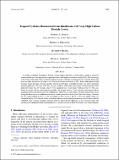| dc.contributor.author | Korty, Robert L. | |
| dc.contributor.author | Huber, Matthew | |
| dc.contributor.author | Zamora, Ryan A. | |
| dc.contributor.author | Emanuel, Kerry Andrew | |
| dc.date.accessioned | 2017-09-05T17:22:23Z | |
| dc.date.available | 2017-09-05T17:22:23Z | |
| dc.date.issued | 2016-12 | |
| dc.date.submitted | 2016-03 | |
| dc.identifier.issn | 0894-8755 | |
| dc.identifier.issn | 1520-0442 | |
| dc.identifier.uri | http://hdl.handle.net/1721.1/111123 | |
| dc.description.abstract | A method to simulate thousands of tropical cyclones using output from a global climate model is applied to simulations that span very high surface temperatures forced with high levels of carbon dioxide (CO₂). The climatology of the storms downscaled from a simulation with modern-day conditions is compared to that of events downscaled from two other simulations featuring 8 and 32 times preindustrial-era levels of CO₂. Storms shift poleward with warming: genesis locations and track densities increase in subtropical and higher latitudes, and power dissipation increases poleward of 20°S and 30°N. The average latitude at which storms reach their maximum intensity shifts poleward by more than 1.5° latitude in the 8 × CO₂ experiment and by more than 7° latitude in the 32 × CO₂ case. Storms live longer and are more numerous in both of the warmer climates. These increases come largely from an expansion of the area featuring favorable conditions into subtropics and midlatitudes, with some regions of the Arctic having the thermodynamic conditions necessary to sustain systems in the hottest case. Storms of category 5 intensity are 52% more frequent in the 8 × CO₂ experiment but 40% less so in the 32 × CO₂ case, largely owing to a substantial decline in low-latitude activity associated with increases in a normalized measure of wind shear called the ventilation index. Changes in genesis and track densities align well with differences in the ventilation index, and environmental conditions become substantially more favorable poleward of about 20° latitude in the warmer climates. | en_US |
| dc.description.sponsorship | National Science Foundation (U.S.) (Grant AGS-1064013) | en_US |
| dc.description.sponsorship | National Science Foundation (U.S.) (Grant AGS-0902780) | en_US |
| dc.description.sponsorship | National Science Foundation (U.S.) (Grant OCE-0902882) | en_US |
| dc.language.iso | en_US | |
| dc.publisher | American Meteorological Society | en_US |
| dc.relation.isversionof | http://dx.doi.org/10.1175/jcli-d-16-0256.1 | en_US |
| dc.rights | Article is made available in accordance with the publisher's policy and may be subject to US copyright law. Please refer to the publisher's site for terms of use. | en_US |
| dc.source | American Meteorological Society | en_US |
| dc.title | Tropical Cyclones Downscaled from Simulations with Very High Carbon Dioxide Levels | en_US |
| dc.type | Article | en_US |
| dc.identifier.citation | Korty, Robert L. et al. “Tropical Cyclones Downscaled from Simulations with Very High Carbon Dioxide Levels.” Journal of Climate 30, 2 (January 2017): 649–667 © 2017 American Meteorological Society | en_US |
| dc.contributor.department | Massachusetts Institute of Technology. Department of Earth, Atmospheric, and Planetary Sciences | en_US |
| dc.contributor.mitauthor | Emanuel, Kerry Andrew | |
| dc.relation.journal | Journal of Climate | en_US |
| dc.eprint.version | Final published version | en_US |
| dc.type.uri | http://purl.org/eprint/type/JournalArticle | en_US |
| eprint.status | http://purl.org/eprint/status/PeerReviewed | en_US |
| dspace.orderedauthors | Korty, Robert L.; Emanuel, Kerry A.; Huber, Matthew; Zamora, Ryan A. | en_US |
| dspace.embargo.terms | N | en_US |
| dc.identifier.orcid | https://orcid.org/0000-0002-2066-2082 | |
| mit.license | PUBLISHER_POLICY | en_US |
